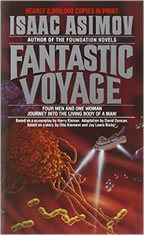Autumn 1966: A Medical Operation that's critical to Military Operations - 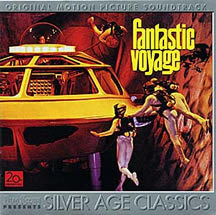 ... an operation vitally urgent to the security of the free world... a voyage into inner space, into the living body, via a submarine and everyone in it shrunk down to the size of a single cell... inserted hypodermically and transported by the body's circulatory system, through the heart and the lungs, into the brain... so that a laser beam might dissolve a life-threatening blood clot, in a brain that holds an earth-imperiling secret....
... an operation vitally urgent to the security of the free world... a voyage into inner space, into the living body, via a submarine and everyone in it shrunk down to the size of a single cell... inserted hypodermically and transported by the body's circulatory system, through the heart and the lungs, into the brain... so that a laser beam might dissolve a life-threatening blood clot, in a brain that holds an earth-imperiling secret....
... $4 million will be spent to make this milestone of entertainment and showmanship.
That was the 1966 promotional pitch to motion picture distributors and theater owners.
A 1966 ad for Fantastic Voyage proclaimed, "You've never been HERE before!"
A 1966 magazine review described the film as "an enlightening excursion through inner space - the body of a man." A newspaper review declared, "... imaginative, inventive, ingenious...."
In the credits, the filmmakers expressed their indebtedness "to the many doctors, technicians, and research scientists whose knowledge and insights helped guide this production."
There's further indebtedness: Even those of us who are not Sci Fi fans and who are not disposed to science fantasy can marvel (still!) at the depictions of the microscopic worlds that inhabit our bodies and are beyond the imaginations of most of us.
Visual Effects and Sound Effects
The actions and scenes of Fantastic Voyage had to be photographed mechanically. No CGI. 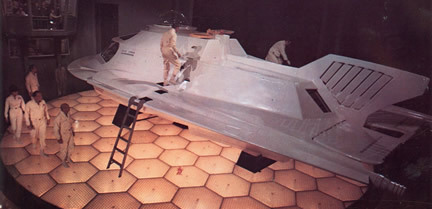
If I understood those who have explained the film's filmmaking marvels, the sub had to be built full-size - interior and exterior; the sets had to be built to the scale of the actors, who, for the out-of-sub-repair-scenes were suspended by wires that had to be painted and lighted in ways that would mask the contrivances. Matte paintings were used to great effect. The bodily fluids, cells, lymphatics, corpuscles, antibodies, plasma and platelets, filaments, reticular fibers, and such were fabricated in large glass tanks using Vaseline along with various oils and gelatinous substances. Imagine a Jacques Cousteau exploration immersed into a lava-lamp.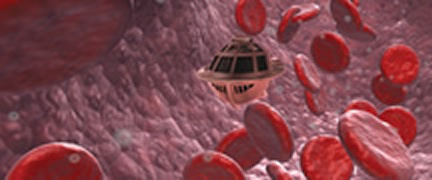
Academy of Motion Picture Arts and Sciences voters acknowledged the picture's marvels with the Oscar for Best Art Direction - Set Decoration, Color; as well as the Oscar for Best Effects, Special Visual Effects. The Society of Motion Picture Sound Editors paid tribute to the sound editing with its feature-film Golden Reel Award.
Reportedly, as late as the 1980s, at some medical schools, clips from the film were shown to illustrate various aspects of human anatomy and physiology, and several concepts of immunology.
The Patient
He's the brilliant scientist who (it is believed) has perfected the technology to miniaturize whole armies and all their artillery and other weaponry. His technology would keep all forces and weaponry miniaturized for transport in something no bigger than the smallest matchbox; to be deployed in stealth and de-miniaturized well within enemy lines and at an enemy's most vulnerable positions.
This scientist, thought to be capable of defying all bio-physics (and thus "the most important man in the world"), has defected from "the Other Side" and the good guys at CMDF (Combined Miniaturization Deterrent Forces) fear sabotage. An attempted assassination resulted in a head injury, which produced the blood clot in his most-valued brain.
He's been placed in deep hypothermia - as low as compatible for sustaining human life: his heart rate has been reduced to only 32 beats a minute; his respirations have been reduced to only 6 per minute.
The Route to the Brain
 The submarine and the crew within are miniaturized into an ampule that is hypodermically injected into the patient's carotid artery.
The submarine and the crew within are miniaturized into an ampule that is hypodermically injected into the patient's carotid artery.
Neither the AAA travel center or MapQuest or Google Maps was any help to me in understanding the "road block" presented by an arteriovenous fistula, which a Mayo Clinic web page tells me is "an abnormal connection between an artery and a vein, which has blood flow directly from an artery into a vein, bypassing some capillaries. When this happens, tissues below the bypassed capillaries receive a diminished blood supply."
All I know - well, what I think I gathered - is that the miniaturized sub has to be re-routed through the jugular vein. From there, to have any chance of making it to the brain (before miniaturization expires), the sub has to go through the heart and withstand its turbulence. 
The medical teams back at CMDF HQ manage to stop the patient's heart for 60 seconds, to allow a somewhat less turbulent passage through the right atrium and out the semilunar valve and on to the pulmonary artery. From there to the lungs, where the crew witnesses oxygenation - the engineering of the breathing cycle. And where - frogman-like - the macho crew member siphons much needed oxygen for the sub, from a corpuscle in the pleural sac of the left lung. 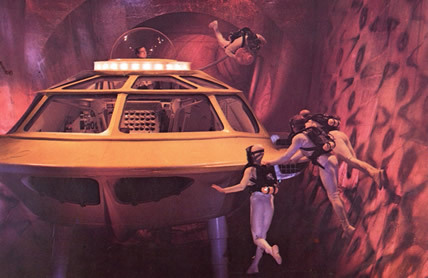
Ahhh, but then, in a lymphatic system, the sub is overheating dangerously due to blockages of its vents. More crew heroics.
With atomic-powered engines running cooler, the sub proceeds to the inner ear through the endolymphatic duct, where the least bit of noise from the operating room will send convulsive vibrations that will tumble the tiny sub.
And, wouldn't ya know it: The sub's intake valves are being clogged by antibodies, which have to be cleared from outside the sub; and which, in the process, attack a crew member as if she was a spec of bacteria to be nullified.
Finally, through the eardrum's subarachnoid cavity (or something in that vicinity), the sub makes its way to the cranium - and still more drama. 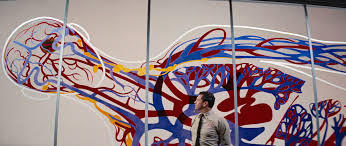
Further difficulties (sabotage?) and delays make the pre-planned extrication impossible. Can the surviving crew "swim" their way to the optic nerve and a possible rescue via a tear duct?
How cool would that be!
The science-fiction maestro (and a professor of biochemistry) was sought after to transform the movie script into a novel. He infused the fiction with a bit more bio-science, and clear demarcations of the anatomical journey. From his deftness, combined with delays in filming and movie production, Asimov's novel was published prior to the release of the film - and might be read as a pre-op procedure, which "oxygenates" the tale.
Artery
In the arterial bloodstream, the miniaturized sub and crew are swept along with the heart-driven flow, amid legions of red corpuscles. Though the size of a bacteria particle, the sub's metal skin seems not to be a target for white blood cells (after all, it's not a mucopolysaccharide cell) - so long as the sub does not damage the tissues of the arterial wall. "The Gothic arches of tissue glimmer, and pulse in time with the heartbeat."
An arteriovenous fistula takes the sub into a whirlpool; it can't buck the arterial current even with the heart in the diastolic stage. The sub must follow the venous current into the jugular vein, and head for the superior vena cava.
Heart
 In "the dark, measureless ocean" of the heart cavity, the sub is steered through the vena cava, heading for the tricuspid valve and then toward the right ventricle.
In "the dark, measureless ocean" of the heart cavity, the sub is steered through the vena cava, heading for the tricuspid valve and then toward the right ventricle.
Assuming that I've somewhat accurately traced the sub's ports-of-call and "rest stops" - its exits, on ramps, off ramps, and re-routings - to this point, here's where I got really lost: There's something about the left ventricle relaxing so that the tricuspid valve would open. But then there's something about the semilunar valve at the end of the pulmonary artery "creaking shut." But then, with blood entering from the right atrium, the tricuspid valve would open, and the sub would shoot through the left ventricle and navigate directly to the brain.
Not in the cards (the cardiovascular cards, to be exact). If I got this remotely straight, the original plan (oh, as revised and detoured) was to navigate directly from the left ventricle to the brain. Don't ask me how or why, but it seems that the sub has entered the pulmonary artery and is being taken from the right ventricle on to the lungs. En route, it encounters capillaries.
Lung
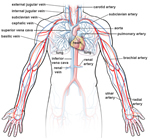 With the sub's oxygen supply depleted by - well, some kind of glitch or mishap (or sabotage) - surfacing for air is not an option. Replenishment is engineered by a delicate, intricate, and perilous siphoning of oxygen molecules from capillaries in the lung walls, by a snorkel. And, oh, by the way, those oxygen molecules (from the alveolar wall) have to be miniaturized to fit into the sub's tanks. (Don't ask me how, but what came to mind was the ingenuity depicted in the film Gravity (any film in which untethered or precariously-tethered astronauts miraculously improvise) and the resourcefulness of some sophisticated and harrowing deep-sea adventure. Don't ask me why. Can't explain.)
With the sub's oxygen supply depleted by - well, some kind of glitch or mishap (or sabotage) - surfacing for air is not an option. Replenishment is engineered by a delicate, intricate, and perilous siphoning of oxygen molecules from capillaries in the lung walls, by a snorkel. And, oh, by the way, those oxygen molecules (from the alveolar wall) have to be miniaturized to fit into the sub's tanks. (Don't ask me how, but what came to mind was the ingenuity depicted in the film Gravity (any film in which untethered or precariously-tethered astronauts miraculously improvise) and the resourcefulness of some sophisticated and harrowing deep-sea adventure. Don't ask me why. Can't explain.)
Pleura and Lymphatics
It seems that the pleural lining is a double membrane surrounding the lungs. Rather than try to make their way back to the arterial system, a new course is set - for the lymphatics. Ahhh, but that will mean more Brownian motion: the unpredictable cascades of microscopic particles that will jolt and tumble the sub. Oh boy.
Vents are clogged by bacteria or antibody molecules, or both. (Beats me.) But the sub is overheating. Another bit of crew heroics.
Inner Ear
Oh my, the crew encounters the Cells of Hensen (which have absolutely nothing to do with Jim Henson and the Muppets) and the Van der Waals Forces, and still more vengeful antibodies. The bio-chemistry of anatomy and physiology is the scientific "umpf" that Isaac Asimov's novel infused into the film script - the mental nutritional value.
Brain
Entering through the subarachnoid cavity at the base of the brain, the sub is maneuvered past the oculomotor nerve so as to avoid damaging any grey matter or memory cells. 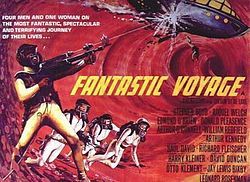
 Even as the ultra-focused brain surgeon dissolves the clot with the ultra-coherent beam of a ruby laser, there is drama back in the sub. Uh oh, now what: as white cells encase the splintering sub, the crew members dedicated to the mission must "swim" for it - along the optic nerve, out through the lachrymal duct, to the cornea, to the lower eyelid.
Even as the ultra-focused brain surgeon dissolves the clot with the ultra-coherent beam of a ruby laser, there is drama back in the sub. Uh oh, now what: as white cells encase the splintering sub, the crew members dedicated to the mission must "swim" for it - along the optic nerve, out through the lachrymal duct, to the cornea, to the lower eyelid.
Eye
There, as the very final seconds of the full 60 minutes of miniaturization are about to expire, the most deft of removals is put into place. Slowly, ever so very carefully, with a felted clamp, the lower eyelid is ever so gently pinched and pulled down so that a microscope slide is positioned to catch a tear drop. Within that tear drop there appears to be a speck of dirt. Could it be that this tear drop is the life-saving conveyance of the crew?
Fast Forward to Neuroscience and Neurosurgery
 For all the film's suspense and wonderment; for all the thrilling imagination, physical science, 1960s technology and artistry that created Fantastic Voyage, I found myself being all the more taken with and impressed by the surgeries performed by Paul Kalanithi - which are so engagingly described in his memoir When Breath Becomes Air, which was published at the time of his most untimely passing.
For all the film's suspense and wonderment; for all the thrilling imagination, physical science, 1960s technology and artistry that created Fantastic Voyage, I found myself being all the more taken with and impressed by the surgeries performed by Paul Kalanithi - which are so engagingly described in his memoir When Breath Becomes Air, which was published at the time of his most untimely passing.
"When Breath Becomes Air" - oxygen for the soul
And I am drawn to the revelations about John Nash, the mentally-troubled mathematician who shared the 1994 Nobel Memorial Prize in Economic Sciences - and whose brain probably held still more revelations; and whose possibilities and declines were told in the biography A Beautiful Mind, and in the Oscar and Golden Globe winning film of the same title.
And, I am all the more intrigued by the sometimes lethal phenomenon of atherosclerosis, which is a kind of arteriosclerosis - which modern medical science is taking on with pharmaceuticals and surgical procedures.
I suppose, in a way, those drugs and procedures course their own voyages through many clogged arterial systems.
And yet it is the neuroscience and neurosurgery of Paul Kalanithi, and those like him, that explore, voyage, and remedy in ways that seem beyond imagining.
Fantastic!
Graphic credits: National Heart, Lung and Blood Institute, NIH; Cleveland Clinic.org; Cleveland Clinic.org; Johns Hopkins Medicine.org; and GP Design Aesthetics.
